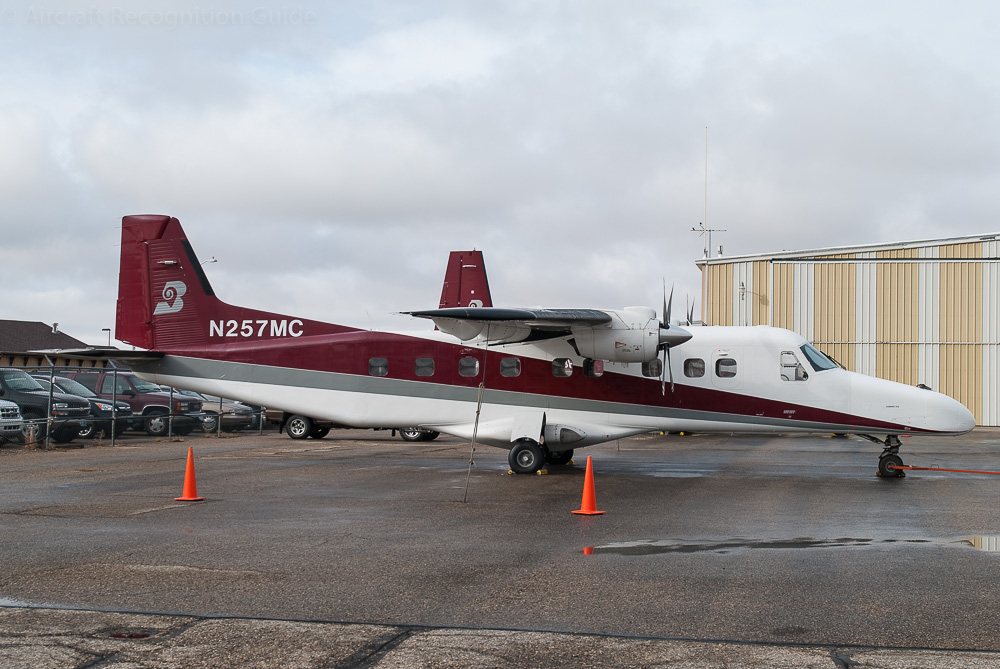
Mitsubishi MU-2
Mitsubishi's first aircraft design after World War II is a high wing, twin turboprop utility aircraft, with a low horizontal stabiliser. Up front the MU-2 has rather large, curved cockpit window. The cabin windows are rectangular and also quite large. The MU-2 has a single wheel main gear, while the nose gear has two wheels. The main wheels are retracted sideways in the fuselage or fuselage fairings. Under each wing is a turboprop engine in a small nacelle. All versions have additional fuel tanks hanging under the wing tips.
Different versions
The different versions of the Mitsubishi MU-2 can be identified by looking at:
- the length of the fuselage
- the shape of the engine nacelles
- the number of cabin windows
- the presence of a radar nose
- the presence and size of tip tanks
- the presence of landing lights in the tip tanks
- the presence of a vane on the tip tanks
- the number of propeller blades (note that all MU-2B versions can be retrofitted with five blade props!)
- the presence of a cargo door in the left rear fuselage
- the presence of a cockpit entrance door
XMU-2 & MU-2A
One prototype XMU-2 and three preproduction MU-2As were built with Turbomeca Astazou Mark IIK engines, which make them clearly distinguishable from the subsequent versions. The nacelles are attached to pylons under the wings and have a ring shaped air intake about halfway the nacelle. It has three blade props. Originally they had no tip tanks but some have been equipped afterwards.
MU-2B
The first production version of the MU-2 was the same as MU-2A, but with TPE331 engines and small tip tanks. These tip tanks have no landing light at the front. The nacelles are directly under the wings, so not on pylons. Like the MU-2A it has a short fuselage with a cabin door underneath the left wing, and two cabin windows on each side. The nose gear retracts backwards and the main gear in the fuselage.
Detail photo of the TPE331 nacelle of all MU-2B subtypes. The nacelle is directly under the wing and the air intake is below and behind the prop spinner.
MU-2C & MU-2D (MU-2B-10)
The MU-2B-10/MU-2C is a non-pressurized version of the MU-2, and was used by the Japanese Ground Self-Defense Force (JGSDF), designated as LR-1.
The MU-2D was the first upgrade of the MU-2 featuring an increase in maximum operating altitude from 23,000 to 25,000 feet. Apart from that, the bladder wing fuel tanks were replaced by wet-wing tanks and the model has four positions for the flaps. So no changes that are cleary visible from the outside.
MU-2DP (MU-2B-15), MU-2F (MU-2B-20), MU-2K (MU-2B-25) & MU-2M (MU-2B-26)
The MU-2DP is similar to the MU-2D, except for the larger (longer) 90-gallon tip tanks, and an upgraded version of the Garrett TPE331. These tip tanks have a smaller diameter than the original ones, are a bit longer and more importantly have a landing light at the front.
The MU-2F is powered by two 665 shp Garrett TPE331s, just as the MU-2DP. It also has the new tip tanks of the subtype. In addition it incorporates a gross weight increase of 570 pounds and fuel capacity was further increased with the addition of a 15-gallon fuel tank in each outer wing panel.
Shortly after the MU-2J, the short fuselage MU-2K was introduced, incorporating all the mechanical changes from the J model. This subtype was also acquired by the JGSDF as LR-1.
The MU-2B-26 (MU-2M) has a weight increase of more than 500 pounds over the then current MU-2K. Also the cabin pressure of the new model was increased to 6 lb/sq in. There are no external differences compared to the MU-2K.
MU-2E
Like the MU-2B-10 (MU-2C) this subtype is non-pressurised and was used by the armed forces of Japan as search and rescue (SAR) aircraft. Therefore it has a radar placed on the nose and bubble windows on each side, under the wings. For the rest it is similer to the MU-2C, so with the old tip tanks. The aircraft is designated by the military as MU-2S.
The MU-2S is the SAR variant of the Japanese Air Force, with a radar nose and an observation window on each side under the wings.
MU-2G (MU-2B-30), MU-2J (MU-2B-35) & MU-2L (MU-2B-36)
This was the first stretched version of the MU-2, with a fuselage that is 1.91 m longer than that of MU-2A to MU-2F. The cabin door has moved to behind the wings and a third cabin window was added on each side as well as one in the cabin door. The MU-2G also incorporates changes in the landing gear: the nose gear is moved slightly aft and retracts forward (with nose gear doors that are open when the gear is extended), and the main gear now retracts into pods against the lower sides of the fuselage. Finally, there are small vanes at the bottom of the tip tanks. For the rest the MU-2G was essentially the same as the MU-2F, except for a somewhat higher tail.
The MU-2B-35 (MU-2J) is equipped with two more powerful “Dash 6” versions of the AiResearch TPE331 turboprop, compared to the MU-2B-30. The engines had an increase in maximum output to 840 shp, although the engine was flatrated at 665 shp. This allows it to fly faster and higher than the previous version. The J-model also got an eleven inch longer cabin.
The MU-2L has a gross weight that has been increased by 350 kg to 5,250 kg and the equivalent shaft horse power of the Garrett AiResearch TPE331 turboprops has been raised to 776. The maximum cabin pressure of this model is also 6 lb/sq in. From the outside the MU-2L could, at the moment of launch, only be identified by their new colour styling.
This MU-2J (MU-2B-35) is an example of the long fuselage MU-2 variants. Note the pods for the landing gear and the visible nose gear doors. The tip tanks have a small vane at the bottom.
MU-2N (MU-2B-36A) & MU-2 Marquise (MU-2B-60)
This new update of the long body MU-2 features four-bladed, broad-chord propellers driven by slower turning flat-rated engines. A new reduction gearbox on the TPE331-5-252Ms reduces prop rpm to 1,591 in the cruise, 20% lower than previous three-bladed versions and also reverses the direction of rotation. An additional window was added to the rear of the cabin as well.
The Marquise has the same engines as the Solitaire, but flat rated to 715 shp. For the rest it is the same as the MU-2N.
The ultimate long body MU-2 version was the Marquise, or MU-2B-60.
MU-2P (MU-2B-26A) & MU-2 Solitaire (MU-2B-40)
The MU-2B-26A, introduced in 1976, has the same improvements over the MU-2B-26 as the MU-2N has over the MU-2L: four-bladed props. However, there seem to exist MU-2Ps with three blade props and they can be fitted with five blade props as modification (like all MU-2Bs). The three blade versions can be recognised from previous versions by a vane on top of the tip tanks.
The last short MU-2 version to be built was the Solitaire. The main difference compared to the MU-2B-26A is the TPE331-10 engine of 1,000 shp that is flat-rated to 665 shp.
The MU-2 Slotaire, shown here, and the MU-2P are short body versions and have four blade props. Compared to previous version also a small vane on top of the tip tanks was added.
Cavenaugh Cargoliner
For dedicated use as high performance cargo aircraft Cavenaugh Aviation Inc. added a crew door in place of a cockpit window and a large cargo door in the rear left fuselage of long body MU-2s. These are known as Cavenaugh Cargoliner. Some aircraft only have the large cargo door and retained the cabin windows.
This MU-2 version clearly has no cabin windows and also the open cargo door on the left side is clearly visible. So this makes it a Cavenaugh Cargoliner.
Confusion possible with
Twin Commander family
This aircraft family is of similar size as the MU-2 and also has high wings and a conventional tail. The main gear of the Twin Commander retracts rearward in the nacelles though, which are thus longer. The wings have no tip tanks. Additionally, the horizontal stabilisers have dihedral. Finally, there are many less prominent differences.
Britten-Norman Islander
The BN-2 Islander has a fixed gear, with the main gear being attached to long struts extending from the wings behind the nacelles. Also the BN-2 has a square fuselage, larger cabin windows and no tip tanks.
Vulcanair AP68TP Viator/A-Viator

This aircraft has an all single wheel retractable gear, attached to stubs on the fuselage, and a long nose to house the nose gear. Other ways to recognise it from the Mitsubishi MU-2 are the different cockpit and cabin windows and engine exhausts.
Dornier 228
While the Do228 is significantly larger than the MU-2, its nacelles, gear and maybe cockpit windows may cause a mixup. The Dornier has more and smaller cabin windows though, a square fuselage and pointed wingtips without tanks.



















